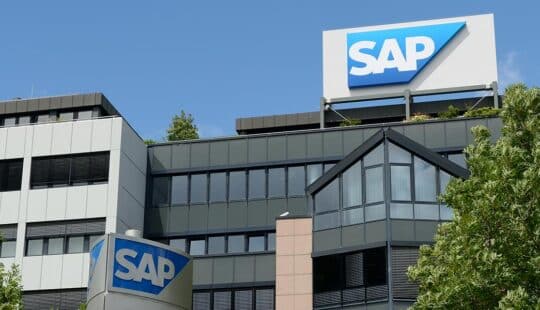Taking the cloud by storm, SAP is RISEing commensurate with customers.
It’s an ill wind that blows no good. Covid-19 may have caught us off-guard but it fast-forwarded fulsome technology adoption that didn’t only avert disaster; it catalysed considerable opportunities.
Fortunately, companies like SAP had solutions in stock, ready to not only restore competitive edge but sharpen it.
“SAP’s strategy has always been to help businesses run as intelligent, sustainable enterprises under all conditions,” reveals a smiling Scott Russell, Executive Board Member of SAP on a recent recce to Bangkok from his base in NYC.

SAP is an acronym derived from System Analysis Program Development that five founders launched in Germany in 1972, when clouds were still just visible masses of condensed water vapor floating in the atmosphere. Today, with 105,000 employees worldwide SAP is the global leader in enterprise application software, aka The Cloud, servers accessed over the Internet and the software and databases that run on them.
“SAP’s end-to-end suite of applications and services enables business and public customers across 25 industries globally to operate profitably, adapt continuously, and make a major difference,” Russell summarises.
Moreover, SAP not only helps companies run their top line and manage their bottom line but also their increasingly mission-critical green line.
“Using our best-in-class technology our customers generate around 87% of total global commerce. All of the big utilities, consumer product manufacturers and service companies use SAP to run their business and target their green goals. With our pivot to the cloud, we’re able to provide that capability at scale with low time to value and low cost to serve.”
Better still, SAP simplifies technology so everyone can consume it. “We help companies track their working capital, inventory levels, financial and human resources and ESG (Environment, Social, Governance) data at the click of a button, so they can do real-time sustainable decision-making.”
Take-up is strong. SAP’s Cloud business accelerated 24% in Q4 2021. In Asia-Pacific, accounting for a third of total business, it’s growing 18%. As for Thailand, where Gartner indicates cloud spending should grow 28.2% to 34.4 billion baht (US$1.1 billion) in 2022, SAP expects a 51% cloud compound annual growth rate by 2025.
“SAP has a proud history with government agencies and enterprises, major conglomerates and family-owned enterprises in Thailand. Our customers have depended on our technology in some cases for 20-25 years. Now, they’re turning to us to make them more agile and sustainable and that’s where the cloud comes in.”
“As Thailand businesses emerge stronger from this pandemic, they need to address such urgent issues as talent retention and development, sustainability and supply-chain resilience. A cloud-only strategy is key to them surviving and thriving.”
Increasingly in the foreground is the challenge of going green. “Boards, markets, governments and consumers are all expecting to deal with companies that do good. To match that you have to manage, measure and track.”
Circular economy is equally front and centre. “Most of the world’s economy is linear and 92% of waste goes to landfill or whatever. That is unsustainable for the planet. The move to a circular economy means at each stage of generating something, you utilize the waste and by-products.”
SAP’s Chasing Zero program brings into focus a world of zero emissions, waste, and inequality.

“Businesses need to lead,” asserts Russell. “It’s our obligation to help the world achieve a sustainable future. But while the targets set at the World Economic Forum are clear, how to achieve them is difficult. You need visibility wherever you are making decisions impacting the environment.”
“SAP can’t do it alone: this is a collective goal where technology companies and industry must partner to solve the challenges.”
The tremendous growth of SAP’s S/4HANA Cloud enterprise resource planning system is attributed to the success of SAP’s signature cloud offering, RISE with SAP, a comprehensive package for business transformation.
When forward thinking enterprises develop new business models to avoid being disrupted and gain efficiencies to fund innovation and transform mission-critical systems without risk, RISE with SAP is their solution.
Global customer, Standard Chartered Bank, uses it to expedite its S/4HANA finance transformation and commitment to net-zero emissions by 2030. Hitachi is transitioning to SAP S/4HANA as it works towards its decarbonization by 2030 and decarbonization of its value chain by 2050.
In Thailand, CPRAM, a food manufacturer, and CP Retailink, an equipment supply and service for 7-Eleven stores, both subsidiaries of CP Group, uses SAP solutions to rethink core business process and set the stage for growth.
“Given very high transaction volumes during the pandemic, they needed real time analytics and performance visibility. Their partnership with us improves their management of complex data, offers better integration, and enables them to scale quickly.”
Also during the pandemic, Thai Medical Glove transformed into an intelligent enterprise through RISE with SAP’s comprehensive solutions for redesigning engagement and buyer journeys.
“In Thailand we’ve seen a real acceleration of human capital management solutions and supply chain planning. Operating in the cloud brings the desired agility. You’re able to get the latest innovations in real time without setting it up yourself.”

SAP’s business network, the world’s biggest, connects 4.5 million companies doing over $3 trillion of trade in 2021.
“COVID had many negatives. You couldn’t run a factory unless you’re able to adhere to health standards. But it probably condensed 10 years of digital transformation into two.”
“Coming out of COVID, the world is divided and volatile. If you’re not investing in technology in the cloud, you’re probably not going to sustain your future.”
Another beauty of SAP is that it’s on a subscription basis. “We might start with a free platform that the customer can take for a trial run. Once they see what the system does for them and come onboard, we bill on a utility basis. That way, we have mutual goals: we want them to maximize the value that they get out of the technology because our revenue is very much linked to their success.”
“Under our ‘help the world run better and improve people’s lives’ banner, we believe that successful businesses going forward will be defined by three characteristics. They have intelligence, meaning data at the right time in the right format. They must be sustainable, managing, measuring and delivering a carbon neutral ESG. And they must be on the network connecting sustainable businesses.”
Nothing less is expected of them.
Note: This article was first published in Bangkok Post.



